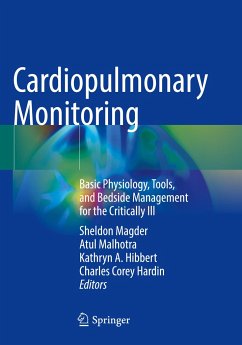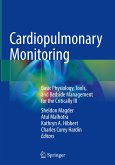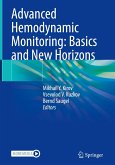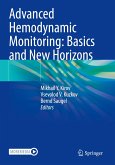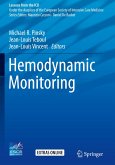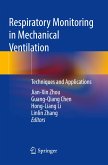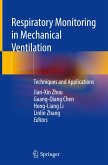Cardiopulmonary Monitoring
Basic Physiology, Tools, and Bedside Management for the Critically Ill
Herausgegeben:Magder, Sheldon; Malhotra, Atul; Hibbert, Kathryn A.; Hardin, Charles Corey
Cardiopulmonary Monitoring
Basic Physiology, Tools, and Bedside Management for the Critically Ill
Herausgegeben:Magder, Sheldon; Malhotra, Atul; Hibbert, Kathryn A.; Hardin, Charles Corey
- Broschiertes Buch
- Merkliste
- Auf die Merkliste
- Bewerten Bewerten
- Teilen
- Produkt teilen
- Produkterinnerung
- Produkterinnerung
This book offers a comprehensive overview of the basic physiology of the cardiac and pulmonary systems, tools for cardiopulmonary monitoring, and related issues in the management of specific conditions. The volume is divided into three main parts. The first part examines the functional basis of normal and abnormal physiology, organized into cardiac and pulmonary units and followed by a "combined" interactive component. The next section discusses cardiopulmonary monitoring tools and variables and is also divided into cardiac (e.g, echocardiography, heart rate, cardiac output), pulmonary (e.g,…mehr
Andere Kunden interessierten sich auch für
![Cardiopulmonary Monitoring Cardiopulmonary Monitoring]() Cardiopulmonary Monitoring202,99 €
Cardiopulmonary Monitoring202,99 €![Advanced Hemodynamic Monitoring: Basics and New Horizons Advanced Hemodynamic Monitoring: Basics and New Horizons]() Advanced Hemodynamic Monitoring: Basics and New Horizons121,99 €
Advanced Hemodynamic Monitoring: Basics and New Horizons121,99 €![Advanced Hemodynamic Monitoring: Basics and New Horizons Advanced Hemodynamic Monitoring: Basics and New Horizons]() Advanced Hemodynamic Monitoring: Basics and New Horizons89,99 €
Advanced Hemodynamic Monitoring: Basics and New Horizons89,99 €![Hemodynamic Monitoring Hemodynamic Monitoring]() Hemodynamic Monitoring82,99 €
Hemodynamic Monitoring82,99 €![Respiratory Monitoring in Mechanical Ventilation Respiratory Monitoring in Mechanical Ventilation]() Respiratory Monitoring in Mechanical Ventilation89,99 €
Respiratory Monitoring in Mechanical Ventilation89,99 €![Respiratory Monitoring in Mechanical Ventilation Respiratory Monitoring in Mechanical Ventilation]() Respiratory Monitoring in Mechanical Ventilation121,99 €
Respiratory Monitoring in Mechanical Ventilation121,99 €![Humidification in the Intensive Care Unit Humidification in the Intensive Care Unit]() Humidification in the Intensive Care Unit114,99 €
Humidification in the Intensive Care Unit114,99 €-
-
-
This book offers a comprehensive overview of the basic physiology of the cardiac and pulmonary systems, tools for cardiopulmonary monitoring, and related issues in the management of specific conditions. The volume is divided into three main parts. The first part examines the functional basis of normal and abnormal physiology, organized into cardiac and pulmonary units and followed by a "combined" interactive component. The next section discusses cardiopulmonary monitoring tools and variables and is also divided into cardiac (e.g, echocardiography, heart rate, cardiac output), pulmonary (e.g, lung volume, pleural pressure, electrical impedance tomography), and combined tools such as radiology/MRI and tissue perfusion tests. The third section concerns the management and application of specific clinical problems such as pulmonary hypertension, cardiac shunts, cardiogenic shock, and ECMO with an emphasis on the physiological basics.
Cardiopulmonary Monitoring: Basic Physiology, Tools, and Bedside Management for the Critically Ill is an essential resource for physicians, residents, fellows, medical students, and researchers in cardiology, critical care, emergency medicine, anesthesiology, and radiology.
Cardiopulmonary Monitoring: Basic Physiology, Tools, and Bedside Management for the Critically Ill is an essential resource for physicians, residents, fellows, medical students, and researchers in cardiology, critical care, emergency medicine, anesthesiology, and radiology.
Produktdetails
- Produktdetails
- Verlag: Springer / Springer International Publishing / Springer, Berlin
- Artikelnr. des Verlages: 978-3-030-73389-6
- 1st edition 2021
- Seitenzahl: 996
- Erscheinungstermin: 3. September 2022
- Englisch
- Abmessung: 254mm x 178mm x 53mm
- Gewicht: 1830g
- ISBN-13: 9783030733896
- ISBN-10: 3030733890
- Artikelnr.: 64761914
- Herstellerkennzeichnung Die Herstellerinformationen sind derzeit nicht verfügbar.
- Verlag: Springer / Springer International Publishing / Springer, Berlin
- Artikelnr. des Verlages: 978-3-030-73389-6
- 1st edition 2021
- Seitenzahl: 996
- Erscheinungstermin: 3. September 2022
- Englisch
- Abmessung: 254mm x 178mm x 53mm
- Gewicht: 1830g
- ISBN-13: 9783030733896
- ISBN-10: 3030733890
- Artikelnr.: 64761914
- Herstellerkennzeichnung Die Herstellerinformationen sind derzeit nicht verfügbar.
Sheldon Magder, MD Professor of Medicine and Physiology Royal Victoria Hospital (McGill University Health Centre) Department of Critical Care Montreal, Quebec, Canada Atul Malhotra, MD Peter C Farrell Presidential Chair and Tenured Professor of Respiratory Medicine University of California San Diego Department of Medicine La Jolla, CA, USA Charles Corey Hardin, MD, PhD Assistant Professor Massachusetts General Hospital Division of Pulmonary and Critical Care Medicine Boston, MA, USA Kathryn A. Hibbert, MD Director, Medical ICU Massachusetts General Hospital Division of Pulmonary and Critical Care Boston, MA, USA
Chapter 1. Introduction.- Part 1: Physiological Basics.- Section 1.1: Cardiovascular Basics.- Chapter 2. Volume and the Regulation of Cardiac Output.- Chapter 3. Function of the Right Heart.- Chapter 4. Function of the Left Heart.- Chapter 5. Pulmonary Vascular Resistance.- Chapter 6. Fluid Filtration in the Microcirculation.- Chapter 7. Physiology of Heart Rate.- Chapter 8. Physiological Aspects of Arterial Blood Pressure.- Chapter 9. Pulsatile Hemodynamics and Arterial Impedance.- Chapter 10. Basics of Fluid Physiology.- Chapter 11. Cerebral Hemodynamics.- Section 1.2: Pulmonary Basics.- Chapter 12. Stress, Strain and the Inflation of the Lung.- Chapter 13. Physiology of PEEP and Auto-PEEP.- Chapter 14. Basics of Ventilation/Perfusion Abnormalities in Critically Ill Ventilated Patients.- Chapter 15. Control of Breathing.- Chapter 16. Respiratory Muscle Blood Flow and Heart-Lung Interactions.- Chapter 17. Surfactant Activity and the Pressure Volume Curve of the Respiratory System.- Section 1.3: Interactions.- Chapter 18. Heart Lung Interactions.- Part 2: The Tools.- Section 2.1: Cardiovascular.- Chapter 19. Blood Pressure Measurements.- Chapter 20. Measurement of Cardiac Output.- Chapter 21. Evaluations of Devices for Measurement of Cardiac Output.- Chapter 22. Basics of Hemodynamic Measurements.- Chapter 23. Cerebral Hemodynamic Monitoring Techniques.- Chapter 24. Transthoracic Echocardiography for Monitoring Cardiopulmonary Interactions.- Chapter 25. Transesophageal Echocardiography for Monitoring Cardiopulmonary Interactions.- Chapter 26. Extra-Cardiac Doppler Hemodynamic Assessment Using Point-of-Care Ultrasound.- Chapter 27. Measurements of Fluid Requirements with Cardiovascular Challenges.- Chapter 28. CO2-Derived Indices to Guide Resuscitation in Critically Ill Patients.- Chapter 29. Microcirculatory Monitoring to Assess Cardio-Pulmonary Status.- Chapter 30. Clinical Assessment and Monitoring of Peripheral Circulation During Shock and Resuscitation.- Chapter 31. Optimizing Oxygen Delivery in Clinical Practice.- Section 2.2: Respiratory.- Chapter 32. Measuring Volume, Flow and Pressure in the Clinical Setting.- Chapter 33. Management of Pleural Pressure.- Chapter 34. Ultrasound Assessment of the Lung.- Chapter 35. Diaphragm Ultrasound: Physiology and Applications.- Chapter 36. Monitoring Respiratory Muscle Function.- Chapter 37. Basics of Electrical Impedance Tomography and its Application.- Chapter 38. Clinical Monitoring by Volumetric Capnography.- Chapter 39. MRI in the Assessment of Cardiopulmonary Interaction.- Section 2.3: Interaction.- Chapter 40. Respiratory Function of Hemoglobin: From Origin to Human Physiology and Pathophysiology.- Chapter 41. Acid Base and Hydrogen Ion.- Part 3: Applications.- Chapter 42. Use of Maintenance and Resuscitation Fluids.- Chapter 43. Identifying and Applying Best PEEP in Ventilated Critically Ill Patients.- Chapter 44. Cardiopulmonary Monitoring in the Prone Patient.- Chapter 45. Cardiopulmonary Interactions in the Management of Acute Obstructive Disease.- Chapter 46. Evaluation and Management of Ventilator-Patient Dyssynchrony.- Chapter 47. Cardiopulmonary Monitoring in the Patient with an Inflamed Lung.- Chapter 48. Ventilation during Veno-Venous Extracorporeal Membrane Oxygenation.- Chapter 49. Vasopressor Support of Patients with Cardio-Pulmonary Failure.- Chapter 50. Cardiogenic Shock Part 1: Epidemiology, Classification, Clinical Presentation, Physiological Process and Non-Mechanical Treatments.- Chapter 51. Cardiogenic Shock Part 2: Mechanical Devices for Cardiogenic Shock.- Chapter 52. Pathophysiology of Sepsis and Heart Lung Interactions: Part 1: Presentation and Mechanisms.- Chapter 53. Pathophysiology of Sepsis and Heart-Lung Interactions: Part 2,Treatment.- Chapter 54. Cardiopulmonary Monitoring of Pulmonary Hypertension and Right Ventricular Failure.- Chapter 55. Monitoring and Management of Acute Pulmonary Embolism.- Chapter 56. Clinical Neurologic Issues in Cerebrovascular Monitoring.- Chapter 57. Delirium in the Critically Ill Patient.- Chapter 58. Obesity in Critically Ill Patients.- Section 4: Epilogue.- Chapter 59. The Future.
Chapter 1. Introduction.- Part 1: Physiological Basics.- Section 1.1: Cardiovascular Basics.- Chapter 2. Volume and the Regulation of Cardiac Output.- Chapter 3. Function of the Right Heart.- Chapter 4. Function of the Left Heart.- Chapter 5. Pulmonary Vascular Resistance.- Chapter 6. Fluid Filtration in the Microcirculation.- Chapter 7. Physiology of Heart Rate.- Chapter 8. Physiological Aspects of Arterial Blood Pressure.- Chapter 9. Pulsatile Hemodynamics and Arterial Impedance.- Chapter 10. Basics of Fluid Physiology.- Chapter 11. Cerebral Hemodynamics.- Section 1.2: Pulmonary Basics.- Chapter 12. Stress, Strain and the Inflation of the Lung.- Chapter 13. Physiology of PEEP and Auto-PEEP.- Chapter 14. Basics of Ventilation/Perfusion Abnormalities in Critically Ill Ventilated Patients.- Chapter 15. Control of Breathing.- Chapter 16. Respiratory Muscle Blood Flow and Heart-Lung Interactions.- Chapter 17. Surfactant Activity and the Pressure Volume Curve of the Respiratory System.- Section 1.3: Interactions.- Chapter 18. Heart Lung Interactions.- Part 2: The Tools.- Section 2.1: Cardiovascular.- Chapter 19. Blood Pressure Measurements.- Chapter 20. Measurement of Cardiac Output.- Chapter 21. Evaluations of Devices for Measurement of Cardiac Output.- Chapter 22. Basics of Hemodynamic Measurements.- Chapter 23. Cerebral Hemodynamic Monitoring Techniques.- Chapter 24. Transthoracic Echocardiography for Monitoring Cardiopulmonary Interactions.- Chapter 25. Transesophageal Echocardiography for Monitoring Cardiopulmonary Interactions.- Chapter 26. Extra-Cardiac Doppler Hemodynamic Assessment Using Point-of-Care Ultrasound.- Chapter 27. Measurements of Fluid Requirements with Cardiovascular Challenges.- Chapter 28. CO2-Derived Indices to Guide Resuscitation in Critically Ill Patients.- Chapter 29. Microcirculatory Monitoring to Assess Cardio-Pulmonary Status.- Chapter 30. Clinical Assessment and Monitoring of Peripheral Circulation During Shock and Resuscitation.- Chapter 31. Optimizing Oxygen Delivery in Clinical Practice.- Section 2.2: Respiratory.- Chapter 32. Measuring Volume, Flow and Pressure in the Clinical Setting.- Chapter 33. Management of Pleural Pressure.- Chapter 34. Ultrasound Assessment of the Lung.- Chapter 35. Diaphragm Ultrasound: Physiology and Applications.- Chapter 36. Monitoring Respiratory Muscle Function.- Chapter 37. Basics of Electrical Impedance Tomography and its Application.- Chapter 38. Clinical Monitoring by Volumetric Capnography.- Chapter 39. MRI in the Assessment of Cardiopulmonary Interaction.- Section 2.3: Interaction.- Chapter 40. Respiratory Function of Hemoglobin: From Origin to Human Physiology and Pathophysiology.- Chapter 41. Acid Base and Hydrogen Ion.- Part 3: Applications.- Chapter 42. Use of Maintenance and Resuscitation Fluids.- Chapter 43. Identifying and Applying Best PEEP in Ventilated Critically Ill Patients.- Chapter 44. Cardiopulmonary Monitoring in the Prone Patient.- Chapter 45. Cardiopulmonary Interactions in the Management of Acute Obstructive Disease.- Chapter 46. Evaluation and Management of Ventilator-Patient Dyssynchrony.- Chapter 47. Cardiopulmonary Monitoring in the Patient with an Inflamed Lung.- Chapter 48. Ventilation during Veno-Venous Extracorporeal Membrane Oxygenation.- Chapter 49. Vasopressor Support of Patients with Cardio-Pulmonary Failure.- Chapter 50. Cardiogenic Shock Part 1: Epidemiology, Classification, Clinical Presentation, Physiological Process and Non-Mechanical Treatments.- Chapter 51. Cardiogenic Shock Part 2: Mechanical Devices for Cardiogenic Shock.- Chapter 52. Pathophysiology of Sepsis and Heart Lung Interactions: Part 1: Presentation and Mechanisms.- Chapter 53. Pathophysiology of Sepsis and Heart-Lung Interactions: Part 2,Treatment.- Chapter 54. Cardiopulmonary Monitoring of Pulmonary Hypertension and Right Ventricular Failure.- Chapter 55. Monitoring and Management of Acute Pulmonary Embolism.- Chapter 56. Clinical Neurologic Issues in Cerebrovascular Monitoring.- Chapter 57. Delirium in the Critically Ill Patient.- Chapter 58. Obesity in Critically Ill Patients.- Section 4: Epilogue.- Chapter 59. The Future.

